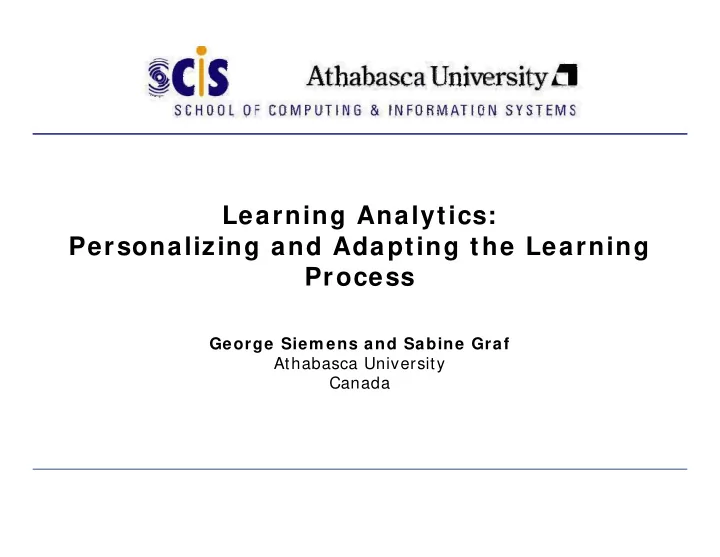

Learning Analytics: Personalizing and Adapting the Learning Personalizing and Adapting the Learning Process George Siem ens and Sabine Graf Athabasca University Canada Canada
Adaptivity and Personalization in Learning Systems How can we make learning systems more adaptive intelligent and personalized more adaptive, intelligent and personalized Based on a comprehensive student model that combines learner information and context information learner information and context information In different settings such as desktop-based, mobile and ubiquitous settings In different situations such as for formal informal and non- In different situations such as for formal, informal and non formal learning Supporting learners as well as teachers Develop approaches, add-ons and mechanisms that extend p pp , existing learning systems 2
Concept of Providing Adaptivity Learner Profile/Model Adaptive Feedback Adaptive Feedback Reading Learning Material Reading Learning Material Context Information Conduct Learning Activities Personalized Advices Device Information Look up Information Providing g Gathering & Gathering & Learning Learning Adaptivity & Analysing Data Experiences Personalization Desktop-based environm. Student Interactions Adaptive Courses Mobile/Ubiquitous environm. Adaptive Learning Sensors Material/Activities 3
Adaptivity and Personalization in Learning Systems Adaptivity based on learning styles Automatic identification of learning styles based on students’ behaviour Dynamic identification and updating of learning Dynamic identification and updating of learning styles Adaptive course provision based on learning styles 4
Identifying Learning Styles Automatic Approach Identifying learning styles is based on patterns of behaviour Identifying learning styles is based on patterns of behaviour Commonly used types of learning objects were used (Content objects, Outlines, Examples, Self-assessment tests, Exercises, Discussion forum) and relevant patterns were derived from these types of learning objects Calculation of learning styles is based on hints from g y patterns A rule-based mechanism is used for this calculation (similar to the approach used in the questionnaire) to the approach used in the questionnaire) Evaluation with 75 students showed that the instrument is suitable for identifying learning styles (results: accuracy of 73% 73% – 79% ) 79% ) 5
Tool for Identifying Learning Styles Developed a stand-alone tool for identifying learning styles in learning systems g y 6
Adaptive Course Provision Developed an adaptive mechanism Incorporates only common types of learning objects Incorporates only common types of learning objects Content Outlines Conclusions Examples Self-assessment tests Exercises Adaptation Features Adaptive sequencing of examples, exercises, self-assessment tests, outlines and conclusions Adapting the number of examples and exercises Ad ti th b f l d i Teachers have to: Provide learning objects Annotate learning objects (distinguish between the objects) l b (d h b h b ) 7
Adaptive Course Provision Evaluation with 437 students showed that: Matched Group: less tim e and equal grades Mismatched Group: ask m ore often for additional learning objects additional learning objects Demonstrates positive effect of adaptivity Extension with respect to Extension with respect to Include more types of learning objects Make adaptive mechanism adaptable for teachers Make adaptive mechanism adaptable for teachers 8
Recommend
More recommend